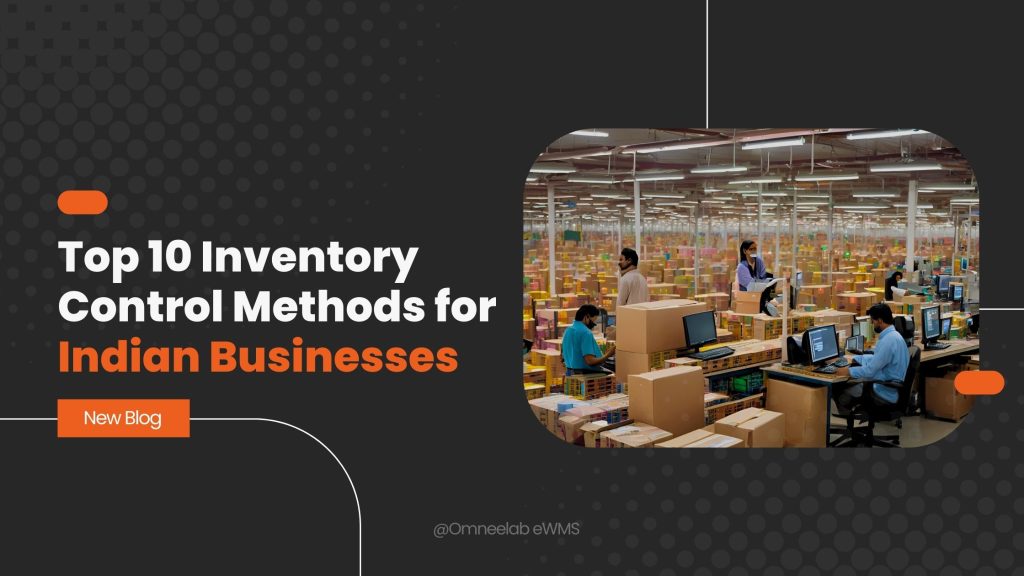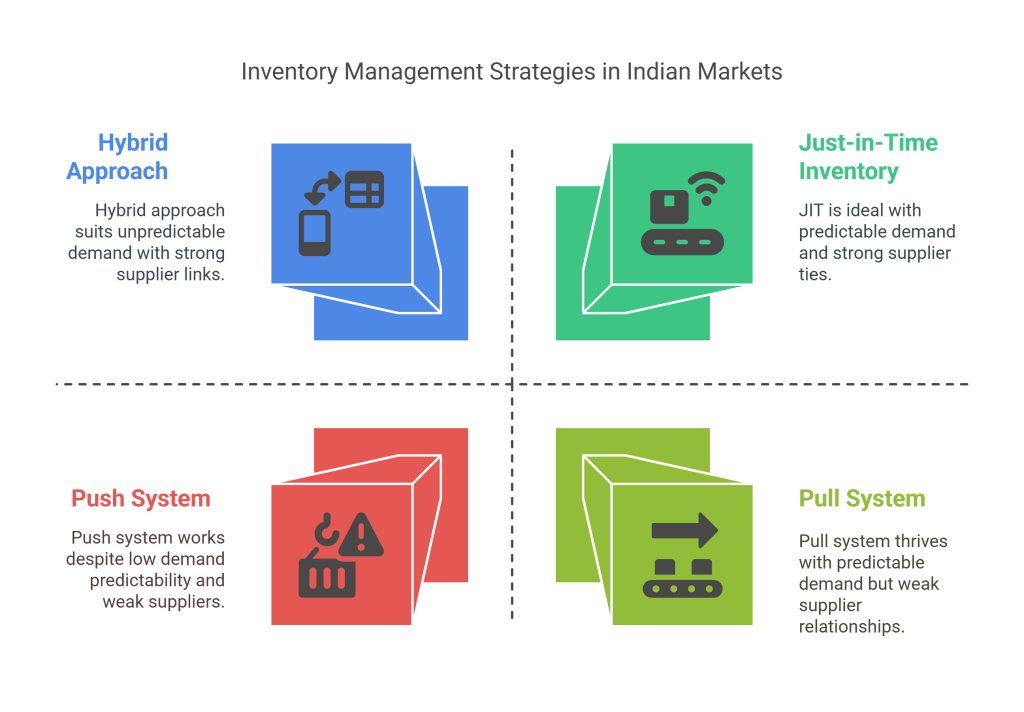Introduction
In an increasingly competitive business landscape, effective inventory control is a cornerstone of success, particularly for Indian businesses. With the diverse nature of the Indian market, inventory management requires a unique blend of traditional and innovative strategies. This article explores the top 10 inventory control methods that have proven effective for Indian businesses.
Inventory control is the backbone of successful business operations. It ensures a balance between stock availability and cost optimization, a challenge that’s particularly acute in the context of Indian businesses. Factors like supply chain complexity, market diversity, and rapid demand fluctuations necessitate a robust inventory control system.

From Just-in-Time inventory management to the use of advanced inventory management systems, there are a number of inventory control methods that businesses can adopt. The choice of method depends on the nature of the business, the industry it operates in, and the specific market dynamics. This article delves into each of these methods, providing a comprehensive guide to effective inventory control in India.
Inventory Control Methods in Indian Market
Just-in-Time Inventory Management
Just-In-Time (JIT) inventory management, a strategy initially developed in Japan, aims to increase efficiency by receiving goods only as they are needed in the production process. The benefits are twofold: it reduces inventory holding costs and minimizes the risk of stock obsolescence.
Given the high cost of warehousing and the rapid pace of product obsolescence in many sectors, JIT is increasingly relevant for Indian businesses. It is particularly effective in industries with predictable demand patterns and strong supplier relationships.
Push and Pull Inventory Techniques
Push inventory technique involves producing goods based on forecasted demand and pushing them into the market. In contrast, a pull system relies on actual customer demand to trigger production. The choice between push and pull depends largely on market predictability and the ability to respond quickly to demand changes.
Indian businesses operating in markets with high demand volatility may find the pull system more effective. On the other hand, businesses with longer production lead times or those operating in more predictable markets may benefit from a push system. A hybrid approach, which combines elements of both, can also be a viable strategy for certain businesses.

Features of Inventory Management Systems
Inventory management systems are software solutions that automate and streamline inventory control processes. Key features to look for include real-time inventory tracking, demand forecasting, order management, and reporting capabilities. These systems can significantly reduce manual effort, minimize errors, and provide valuable insights for decision-making.
In the Indian business context, the adoption of inventory management systems is on the rise. With the increasing complexity of supply chains and the need for real-time decision-making, these systems can provide a competitive edge. They can help businesses optimize their inventory levels, reduce stockouts and overstocks via buffer stocks, and improve overall operational efficiency.
Periodic Inventory Methods
The periodic inventory method involves counting inventory at specific intervals, typically at the end of a financial period. This method provides a snapshot of inventory levels at a particular point in time, helping businesses assess their inventory performance and make necessary adjustments.
For Indian businesses with a large volume of inventory or those operating in sectors with low inventory turnover, the periodic inventory method can be a cost-effective approach. It allows businesses to keep track of their inventory without the need for continuous monitoring. However, it may not be suitable for businesses that require real-time inventory information.
Pros and Cons of Inventory Management
Effective inventory management can lead to cost savings, improved customer satisfaction, and increased operational efficiency. However, it also comes with challenges such as the need for accurate demand forecasting, the risk of overstock or stockout, and the requirement for continuous monitoring and adjustment.
For Indian enterprises, the benefits of effective inventory management often outweigh the challenges. By adopting suitable inventory control methods and leveraging technology, businesses can overcome these challenges and reap the benefits of optimized inventory control.

ABC Analysis in Inventory Management
ABC analysis is a method of categorizing inventory into three categories: A items are high-value products with low sales frequency, B items are moderate-value products with moderate sales frequency, and C items are low-value products with high sales frequency. By identifying the significance of each item, businesses can optimize their inventory management efforts.
In the context of Indian businesses, ABC analysis can streamline inventory management efforts by focusing resources on high-value items. By understanding the sales pattern and cost implications of each category, businesses can make informed decisions about procurement, storage, and distribution.
Economic Order Quantity (EOQ)
The Economic Order Quantity (EOQ) is a formula that determines the optimal order quantity that minimizes total inventory costs, including holding costs and order costs. It’s a valuable tool for inventory management optimization.
Indian businesses can greatly benefit from applying the EOQ model. By determining the optimal order quantity, businesses can minimize their inventory costs and improve overall profitability. However, it’s important to note that EOQ assumes consistent demand and lead time, which may not always hold true in the dynamic Indian market.
Safety Stock in Inventory Management
Safety stock is the extra inventory held to prevent stockouts caused by unpredictable variations in supply and demand. It serves as a buffer to ensure smooth operations and customer satisfaction.
In the Indian business environment, where demand fluctuations and supply chain disruptions are not uncommon, maintaining safety stock can be crucial. It can help businesses avoid lost sales and retain customer loyalty. The key is to find the right balance to avoid overstocking, which can lead to increased holding costs and potential obsolescence.
Dropshipping and Inventory Management
Dropshipping is a business model where the retailer does not keep goods in stock but instead transfers the customer orders and shipment details to either the manufacturer, another retailer, or a wholesaler, who then ships the goods directly to the customer. This model minimizes the risk of holding inventory, reduces storage costs, and broadens product offerings.
Dropshipping can be a game-changer for Indian businesses, especially for small to medium-sized enterprises (SMEs) and startups with limited capital. It allows businesses to offer a wide range of products without the need to invest in inventory or warehousing. However, businesses need to ensure reliable supplier relationships, as they are entirely dependent on the supplier for order fulfillment.
Consignment Inventory for Indian Businesses
Consignment inventory is a business arrangement where a supplier provides goods to a reselling partner, but retains ownership of the inventory until it’s sold. This model reduces the financial risk for the reseller and provides the supplier with a larger distribution network.
For Indian businesses, particularly SMEs, consignment inventory can provide access to new markets without a significant upfront investment. However, businesses need to be aware of potential downsides such as a lack of control over the inventory and the dependency on the reseller for accurate sales reporting.
Comparison and Decision-Making
Each inventory control method has its own set of benefits and challenges. Just-In-Time management can lead to cost savings and efficiency, but it requires accurate demand forecasting and reliable suppliers. On the other hand, safety stock and Economic Order Quantity models provide a safety net against demand fluctuations, but they can also lead to overstocking and increased holding costs.
Dropshipping and consignment inventory can be beneficial for businesses with limited capital, but they also require strong supplier relationships and can result in a lack of control over the inventory. Finally, ABC analysis and inventory management systems can help optimize inventory control efforts, but they also require investment in terms of time and resources.
How to Choose the Best Method for Your Business
Choosing the best inventory control method for your business depends on several factors including the nature of your business, the predictability of demand, the reliability of your suppliers, and your capacity to invest in inventory control efforts. It’s important to thoroughly evaluate each method and consider its applicability to your specific business context.
Overview of Indian Inventory Management Software
Role of Software in Effective Inventory Control
Inventory management software can greatly enhance the efficiency and effectiveness of inventory control efforts. It provides real-time inventory tracking, automates routine tasks, and provides valuable insights for decision-making. In the Indian context, where businesses are dealing with increasing market complexity and demand volatility, inventory management software can provide a significant competitive advantage.
Top Inventory Management Software Options in India
Several inventory management software options are available in the Indian market, each with its own set of features and benefits. Some of the top options include Omni Stock, Tally ERP 9, SAP ERP, and Zoho Inventory. These solutions offer a range of features such as real-time inventory tracking, demand forecasting, and integration with other business systems, providing businesses with a comprehensive tool for inventory control.
Best Practices for Inventory Control in Indian Businesses
Effective Stock Control Techniques
Effective stock control is crucial for optimizing inventory levels, minimizing costs, and ensuring customer satisfaction. Some key techniques include setting minimum and maximum stock levels, using FIFO (First In, First Out) method for stock rotation, regularly auditing physical inventory, and using an inventory management system for real-time tracking and analysis.
Inventory Forecasting Strategies
Accurate inventory forecasting can greatly enhance inventory control efforts. It involves predicting future inventory requirements based on historical sales data, market trends, and business growth plans. Techniques such as time-series analysis, trend analysis, and seasonality adjustments can be used for inventory forecasting.
Optimizing Procurement and Inventory
Optimizing procurement processes can lead to significant improvements in inventory control. This involves selecting reliable suppliers, negotiating favorable terms, and timing procurement to align with demand forecasts. In addition, regular review and adjustment of inventory levels can help keep stock levels optimal.
Future of Inventory Control in India
The future of inventory control in India is likely to be shaped by emerging trends and technologies such as AI and machine learning, cloud-based inventory management systems, and automation. These technologies can provide predictive insights, enhance real-time tracking, and automate routine tasks, thereby significantly enhancing inventory control efforts.
To prepare for the future, businesses should stay abreast of emerging trends, invest in technology, and continuously enhance their inventory control skills and knowledge. Businesses that are proactive in adopting new methods and technologies are likely to gain a competitive edge in the market.
Conclusion
From Just-In-Time management to the use of advanced inventory management systems, there are various inventory control methods that can help Indian businesses optimize their inventory levels, minimize costs, and enhance customer satisfaction. The choice of method depends on the specific business context and requires careful consideration and ongoing adjustment.
Mastering inventory control in the Indian market involves a combination of effective methods, use of technology, and continuous learning and adaptation. By implementing these strategies, Indian businesses can turn inventory control into a key driver of business success.
FAQs
A: Inventory control is crucial for Indian businesses as it helps balance stock availability and cost optimization. It’s particularly important given factors like the complexity of supply chains, diversity of the market, and rapid demand fluctuations commonly experienced in India.
A: JIT inventory management can be particularly effective in industries with predictable demand patterns and reliable supplier relationships. It helps reduce warehousing costs and minimizes the risk of stock obsolescence.
A: Inventory management software can provide a significant competitive edge in the Indian market by offering real-time inventory tracking, automating routine tasks, and providing valuable insights for decision-making.
A: Businesses can stay ahead by keeping up with emerging trends, investing in technologies like AI and machine learning, and continuously enhancing their inventory control skills and knowledge.
A: Choosing the right inventory control method depends on several factors, including the nature of the business, predictability of demand, reliability of suppliers, and capacity to invest in inventory control efforts. It’s important to thoroughly evaluate each method and consider its applicability to the specific business context.

Kapil Pathak is a Senior Digital Marketing Executive with over four years of experience specializing in the logistics and supply chain industry. His expertise spans digital strategy, search engine optimization (SEO), search engine marketing (SEM), and multi-channel campaign management. He has a proven track record of developing initiatives that increase brand visibility, generate qualified leads, and drive growth for D2C & B2B technology companies.